Say hello to the DS3 Cabrio
We welcome a new, open-topped arrival to the Our Cars fleet. The Citroen DS3 Cabrio offers style, fun and fresh-air motoring so it's ideal for the summer.

Date: 29 April 2014 | Current miles: 610 | Claimed economy: 47.9mpg | Actual economy: 38.9mpg
Just in time for summer, we welcome the first open-topped model to the Our Cars fleet – the Citroen DS3 Cabrio. I’ve picked a 156PS turbocharged petrol model in DSport+ trim, finished in £495 Shark Grey metallic. Including the eMyWay navigation the total price was a pretty steep £22,265.
That’s quite a lot, but it’s got impressive performance, plus gizmos and gadgets including automatic lights and wipers and – of course – a retractable fabric roof. The roof itself is finished in a shade Citroen has called Infinity Blue – but Cadbury’s Purple is probably more fitting. The roof can be raised or lowered on the go at speeds up to 70mph, so it’s ideal when caught out in a rain shower on the go.
Being a top-of-the range model, our DS3 Cabrio has leather upholstery and a carbon-fibre effect dashboard, along with a top-quality audio system with iPod and Bluetooth connectivity. On the downside, this system has no DAB radio and that’s a real shame because it’s something I use regularly.
Another problem that immediately presented itself was the tiny boot opening, which is low down and difficult to access, making life tricky if you’ve got anything substantial to load or unload. Luckily, so far I’ve had nothing particularly large to carry but that will no doubt change.
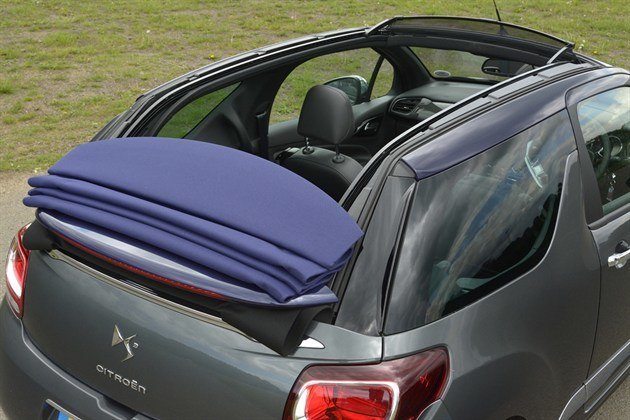
Our DS3 comes with a Cadbury Purple roof
It’s easily forgiven when you fold the roof back and go for a drive on a sunny day though. The engine is great and whirs, chirps and burbles with genuine character, something sorely absent from a lot of modern cars. It drives the front wheels through a slick, precise, nicely weighted six-speed transmission which is very nice to use.
Performance is impressive – 0-62mph takes 8.2 seconds, which is unlikely to worry the current crop of hot hatches but is more than enough to have fun. Fuel economy is good, too, at 47.9mpg according to official figures. It’s not the most frugal car in the world but compared to other vehicles with nearly 160PS it’s not bad at all.
In reality it’s been closer to 40mpg so far, but that’s been in town driving or on fun blasts through the countryside – it would be easy to better that and I expect the average to increase over the coming months as I get used to the car. Emissions are 137gkm, which places it in VED band E and means annual tax is £130.
Over the coming months there’s a few adventures planned for the DS3 Cabrio – open-topped cars are meant to be driven for fun and not just to and from the shops – but I’ll also be treating it as an everyday car to see if the addition of a folding fabric top has compromised the popular DS3 in any way. First impressions are good, but only time will tell if my opinion stays the same.
Is the DS3 a real cabriolet?
The fabric roof on our DS3 cabriolet doesn't retract as fully as some - but does that really matter?
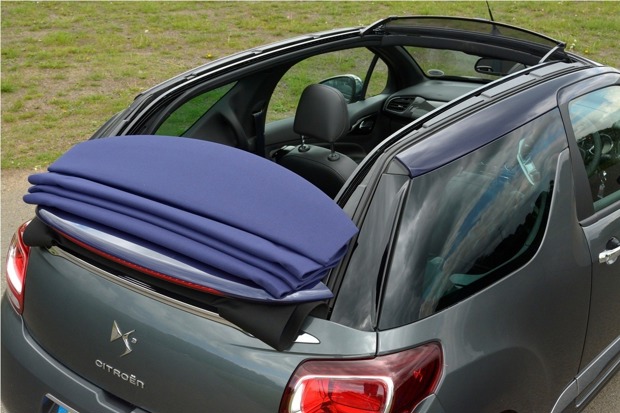
Date: 13 May 2014 | Current miles: 933 | Claimed economy: 47.9mpg | Actual economy: 39.2mpg
According to the Oxford English Dictionary, a cabriolet is either ‘a light two-wheeled carriage with a hood, drawn by one horse’ or ‘a car with a roof that folds down.’ So our DS3 certainly is a cabriolet by definition (not the horse-drawn one), but can you really compare it to something with a fully folding roof, like a MINI Convertible?
The MINI has a similar price tag, but rather than the DS3’s retracting top with rigid door pillars and fixed rear side windows, the MINI has a fabric top that fully retracts. When people think of open-topped motoring they’re more likely to picture the MINI Convertible than the DS3 Cabrio.
But if the DS3 roof mechanism is off-putting, don’t fret. It’s actually the best of both worlds, combining the sharp dynamics of a fixed roof car with enough sunshine and wind to connect you to the world outside. Security is better too – it should be harder for an unscrupulous person to get into the DS3 than a traditional drop-top.
With the roof fully retracted the cabin is bright and you’re bathed in sunlight sufficiently to get burned – something I found out the hard way. Lowering the windows gives you more or less the full cabriolet experience, although you always feel a little more hemmed in than you do in a car with a fully-retractable top.

DS3 roof does its best impression of a deflated accordion
Another disadvantage to the DS3’s layout is that there is nowhere for the folding roof to go. Instead of being neatly hidden in the boot it bunches up like a deflated accordion above the bootlid – and it completely obscures rearward visibility. I’ve found myself relying on the wing mirrors.
On the plus side you can set the roof exactly where you want it – so you can open it just a little like a sunroof, or retract almost it entirely but leave the rear window in place. That’s good on the motorway, or if you've got to reverse out of a parking space on a sweltering hot day in a baking oven of a car.
And, when that sunshine goes – which it inevitably will in Britain – you can fold the roof back up (or down again) at any speed below 70mph. This is a great advantage over a lot of convertible cars, which either have to be stopped or driven very slowly if you want to operate the roof.
The DS3 Cabrio might not be a true cabriolet by everyone’s standards, but it’s easy to argue a case for it nonetheless. With the roof down it’s offers an experience not too far different from something like a MINI Convertible or a Mazda MX-5. It’s not quite as involving, but the other advantages more than make up the shortfall.
Confused Infotainment
Getting the hand of the infotainment system in our DS3 Cabrio takes some time and it's starting to feel pretty dated.
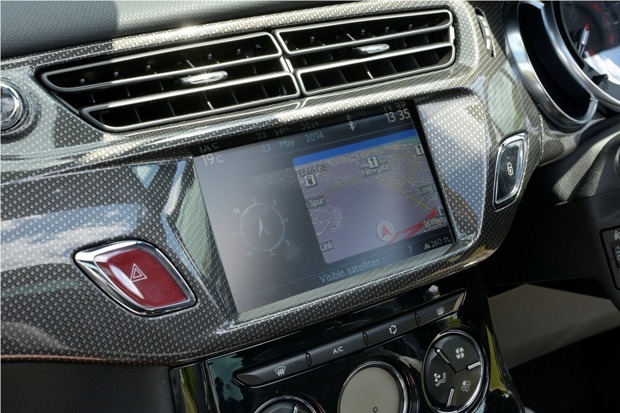
Date: 27 May 2014 | Current miles: 1006 | Claimed economy: 47.9mpg | Actual economy: 39.2mpg
Our DS3 Cabrio might be on a 14 plate, but the DS3 itself was launched in 2010 – and even then some of the details were a bit out of date. One of those is the infotainment system which, although very pretty to look at, is far from the most user-friendly system on sale.
The screen itself isn’t touch sensitive. Everything is controlled from a collection of buttons below the air conditioning system, with a rotary dial and separate arrow buttons for moving from menu to menu. The problem is that the dial isn’t also a joystick, so you can’t move from menu-to-menu without moving your hand to a separate button and pressing it.
It makes navigating through the various menus cumbersome compared to the BMW iDrive based system in the MINI or a more modern touchscreen system. You do get used to it, of course, but it can regularly lead to frustration when trying to get to a certain folder in a music device or when switching from one mode to another.
The navigation system has a flaw too - it doesn’t accept seven-digit postcodes. Generally people will navigate simply by putting in the full postcode of their destination and clicking go, myself included. But that’s not possible with the DS3 - instead you have to program the first four or five digits and then select a street and number.
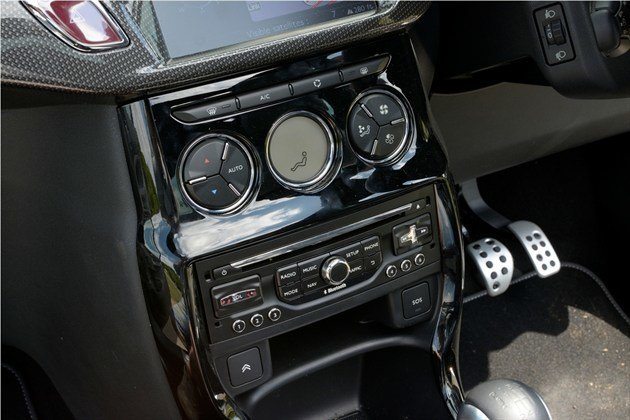
The DS3 stereo and infotainment system are starting to look old hat
That’s fine if you know the street and house number, but that’s not always possible and can lead to you arriving at the wrong end of a one-way street or even in completely the wrong place. Again, it’s something you get used to fairly quickly when you drive the car regularly, but it’d be nice if the system was perfect from the get-go.
There are some nice touches though. You can choose a colour theme, for one, plus you can arrange the screen layout with a mode button to display a mixture of different things – so you can have the radio screen alongside the navigation screen simultaneously, or you can prioritise one thing over the other.
Citroen has got with the times recently and does produce a brand-new and better infotainment/navigation system, which can be found in the C4 Grand Picasso. It’s a shame it wasn’t adopted for the DS3, because it would really improve a weak link in an otherwise impressive package.
The slightly confusing controls and iffy sat nav are part of eMyWay Signature, an optional £800 pack. It might be wise to avoid this and save some cash, but it does include some other key bits and pieces like an excellent hi-fi system which is very impressive indeed, producing crisp sound and powerful bass.
You really need that powerful audio system if you want the roof down and still want to hear music properly when travelling at high speed – and it’s better to have a built in nav system that’s a bit tricky to use than an aftermarket one that you’ll forget and not have when you really need it. So really it’s down to preference – the DS3 infotainment might be a pain in the backside at times, but once you’re used to it it’s fine.
Living with a tiny boot
The DS3 Cabriolet is very similar to its hard top counterpart - but the boot opening is much, much smaller. What's it like to live with?

Date: 10 June 2014 | Current miles: 1236 | Claimed economy: 47.9mpg | Actual economy: 39.2mpg
The roof mechanism on the DS3 Cabriolet collects the fabric up into a sort of concertina and folds the rear windscreen down onto the parcel shelf. This is good for keeping the structure of the car rigid and keeping weight down, but it’s bad news for the boot.
The actual load area itself isn’t all that small. It has a volume of 245 litres, which is only 40 litres shy of the regular hatchback – but it’s the opening that poses problems. The boot hatch flips up behind the windscreen in a pretty cool way, but it leaves a load hatch that’s low down and tiny.
Even getting things like shopping bags in is awkward and it’s even harder to get them back out again if they’ve slid forward – you have to crouch down and reach inside. For a one-car family this can become seriously bothersome very quickly. Taking a trip to the local rubbish tip with a load of garden waste or recycling is more or less impossible.
The rear seats do fold forward, so carrying long items like flat pack furniture isn’t impossible, but it’s far from easy and it’s a similar story with things like large suitcases. A trip away is easier with a few soft bags than a big, full-sized hard case.

Citroen DS3 Cabrio boot is not shopping friendly
Everything is manageable though. Shopping trips might be awkward but they’re not impossible and, if things get too tight, you can always put things in the back seat. Of course, you can’t use the rear seats for storage if you’re carrying passengers – but that’s another area in which both the DS3 cabriolet and the regular DS3 hatchback suffer. Rear space is tight, particularly with tall passengers up front. Children and young teenagers will be fine but carrying fully-grown adults in any comfort isn’t possible.
But this might not be a problem for the usual cabriolet buyer, who will likely leave practicality at the door when they choose to buy something like the DS3 Cabrio. You can’t really be too hard on it anyway – all of its practicality problems are shared in some way or another with rival cars like the MINI Convertible and Roadster, or the Fiat 500C.
Frustrating though the DS3’s practicality can be, it’s already something I’ve learned to live with. Visiting a supermarket is irritating rather than impossible - but let’s face it, food shopping is never fun, even in an estate car. At least with a sporty cabriolet you can enjoy getting there and driving home...
On a day trip or short break, or when giving a lift, the DS3 manages fine as it is. That said, the novelty of a drop-top hasn’t worn off just yet. In a few months time when the sun has cleared off for another year I might have an entirely different opinion of the DS3’s shortcomings.
The first long trip
We take the DS3 on its first long trip, covering 500 miles in a weekend. So how does the open-top Citroen cope on the motorway?
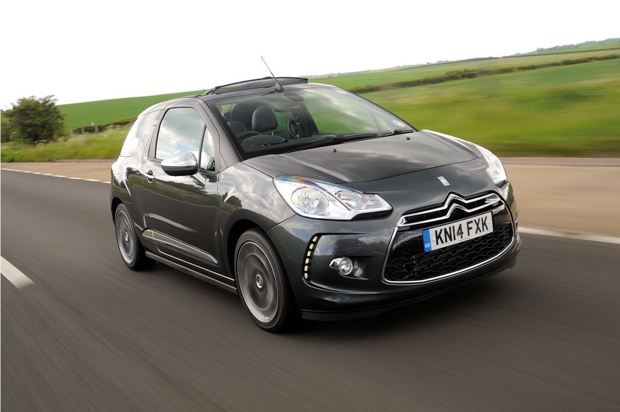
Date: 24 June 2014 | Current miles: 1793 | Claimed economy: 47.9mpg | Actual economy: 39.2mpg
With previous cars I've run, weekend trips have often been very long, sometimes covering 500 miles every fortnight. More recently, owing to a change of circumstances, it’s become a less common occurrence so it took a while for me to take the DS3 on a long trip, this time to see family in the North East of England.
It wasn’t a smooth journey by any stretch of the imagination, thanks to rush hour traffic and numerous accidents, but on the open motorway the DS3 Cabrio is perfectly capable car. Despite having a fabric roof it’s reasonably quiet at motorway speeds and its 155PS petrol engine is more than capable at higher speeds.
Being turbocharged, the engine offers a good amount of torque at low engine speeds, so changing down a gear isn’t necessary when you want to overtake. That, along with cruise control for open stretches and a speed limiter for those ever more common speed managed sections, makes the DS3 a good motorway mile muncher.
One of the best aspects of the DS3 Cabrio is that its roof can be raised or lowered at speeds up to 70mph, so if you spot a dark cloud ahead you don’t have to pray there’s a motorway service station between you and the upcoming cloudburst. Once the rain has passed you can open the roof back up. With Britain’s weather being so unpredictable that came in handy several times.
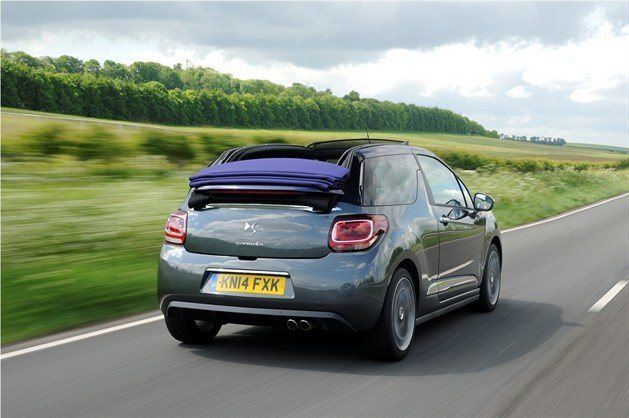
Something I discovered by accident when sat in a traffic jam is that the wind break above the windscreen can be raised or lowered, you just pop it in or out with your hand. Oddly the cabin seems quieter at speed with this down and that also stops it collecting dozens of dead bugs, so it’ll be staying down from now on.
With the roof down things get pretty noisy at motorway speeds. You have to speak up to have a conversation and if you want to listen to music it has to be cranked, but it’s rarely ever obtrusive in the front. The back seat is a different story, of course, but it’s a bit too tight for long trips anyway so the restricted legroom would probably be more concerning than a bit of a breeze.
One slight concern on a longer cruise is that the engine isn’t particularly efficient. At motorway speeds the instant fuel consumption readout shows low 40s, which is short of the official combined cycle figure of 47.9mpg. Knocking a few miles-per-hour off the cruise speed would increase this, of course, but I expected a little better.
Aside from that there is little to report. There’s no optional gadgetry like adaptive cruise control or lane keep assist, but that’s usually reserved for more expensive machines anyway. The DS3 Cabriolet might be a small open-topped car but it’s just as easy to live with on the motorway as a big diesel, even if it isn’t quite as refined.
Citroen’s cabriolet past
We look back at some of the DS3's predecessors. It turns out Citroen has been making drop-top cars for a long time.
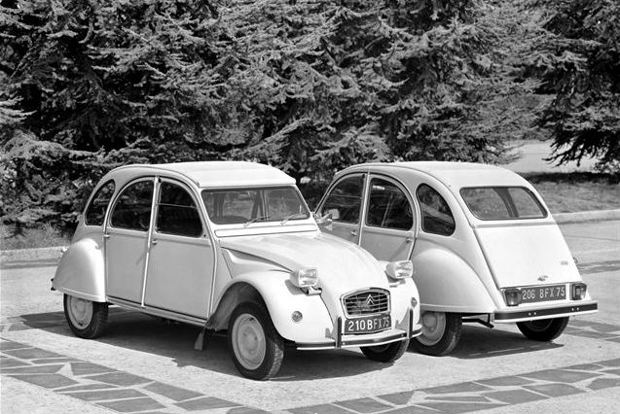
Date: 8 July 2014 | Current miles: 2036 | Claimed economy: 47.9mpg | Actual economy: 38.7mpg
Citroen might not be known for its drop-top models but it has been building convertible cars for quite some time. In fact you can trace the lineage of the ‘peel back’ fabric top of our DS3 back to the Citroen 2CV, which was available with a similar system, albeit a far simpler, manually operated one. I’ve traced the DS3 Cabriolet back to where it all started.
Citroen 2CV
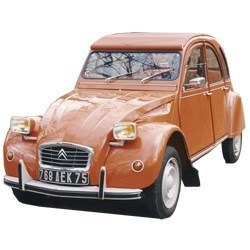
Even the very earliest 2CV models had a fabric roof, although that was as a function of the car’s absolute simplicity rather than a stylish embellishment. Nonetheless, as the car became a quirky fashion accessory rather than mass-market transport for rural types, the fabric top started to be treated as a sunroof.
Unlike the electronically operated system on our DS3 Cabrio the retractable fabric top on the 2CV was far simpler – it’s undone and rolled back. Over the 2CVs long production run various convertors made more elegant drop-top versions including the delicately styled, two-seat Hoffman Cabriolet, launched in 1988.
Citroen DS Decapotable
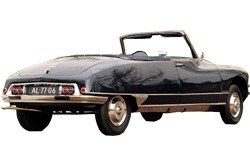
Many coachbuilders used the original DS as a basis for cabriolet conversions but only one was sold officially by Citroen. It was the version built by Henri Chapron and it was so well received that it became part of the official DS range. Despite its beautiful styling it wasn’t produced in huge numbers, with little more than 1300 built.
It was quite expensive when new, costing more than double the price of a saloon. As a result surviving cars are worth a lot of money. Again, the roof was a manually operated affair, unlike the electric system on the DS3. Most surviving DS3 Decapotable models will only ever get used on sunny days, so that should be no real problem!
Citroen Mehari
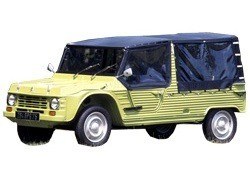
The Mehari was built to cash in on a burgeoning market for beach cars like the Mini Moke. It used the underpinnings of a 2CV and corrugated plastic bodywork, meaning the Mehari was incredibly simple. It had the key controls such as lights, dials and seats but not much more.
The roof was something of an afterthought, making the car look a lot like a tent when it was in place. The Mehari isn’t a common sight in the UK, but travel to a Mediterranean area and you’ll almost certainly see one wearing plenty of sunshine related patina.
Citroen C3 Pluriel
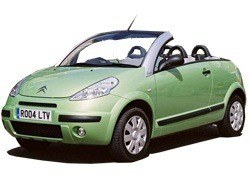
Citroen didn’t make any drop-top cars for quite some time, but it tried again with the C3 Pluriel in 2003. It was something of a confused mishmash. It had a fabric roof that folded back to the rear window. The window itself could also be folded into the boot, making for a car a lot like our DS3 Cabrio.
But it didn’t stop there. Owners could also remove the rails to which the roof is attached to make the car into a full, traditional cabriolet. The only problem with this is that you have to leave them at home, so if it rains while you’re on a drive you’re knackered. Not great for the UK...
Citroen DS3 Cabrio

So Citroen had another crack at the cabriolet recipe with the DS3 – but this time it seems to have got the recipe right. With a roof that can be folded at speeds up to 70mph it’s ideal for the UK, where rain showers can catch you out at any time of the year.
Add to that a good level of body rigidity and you’ve got a car that’s great fun to drive, whether the top is up or down. So far it’s been a great summer companion, but we’ve yet to have a really cold spell – so it remains to be seen how well it copes when the warm weather ends.
Back to France: Part one
With summer on the way it's time for a road trip so we take the DS3 Cabrio back to the place it was built - Poissy in France.

Date: 22 July 2014 | Current miles: 2635 | Claimed economy: 47.9mpg | Actual economy: 40.1mpg
People don’t usually buy cabriolets to go to the shops – they’re meant for much more that. Trips to the beach, adventures in beautiful countryside or holidays abroad are usually on the cards when buyers pick out something like the DS3 Cabrio – so it would be remiss of us not to find out how well the car performs on a big trip.
In our case that trip would be a hop across the channel to France, then to Paris – specifically Poissy, where the DS3 was originally built before it was shipped to the UK. Here’s how it all went.
0530
Woken up by an alarm. It’s immediately switched off with the snooze button and ignored – this is too early. Ten minutes later it’s time to actually get up, check everything including passports and then eat something, specifically bacon, before getting out on the road. I’ve mentioned before that travelling with soft bags is a good idea with the DS3 because of its small boot opening, so that’s what we do.
0615
It’s just gone 6AM but apparently that’s no reason to expect the M4 out of London to be free-flowing. Thankfully it’s just a hiccup caused by an inattentive slow-mover. Our plan to get to the Eurotunnel before the M25 grinds to its typical rush-hour halt is successful – even if the Chunnel itself is a little bit further away than I thought it was going to be.
0800
A very useful Flexiplus ticket means we can arrive and depart on the Eurotunnel Shuttle more or less whenever we want – and we can eat croissants and pomme-puree in a dedicated lounge. The crossing takes about 35 minutes, but checking in, boarding and various other shenanigans mean it takes a little over an hour from arriving to driving off the train into France.
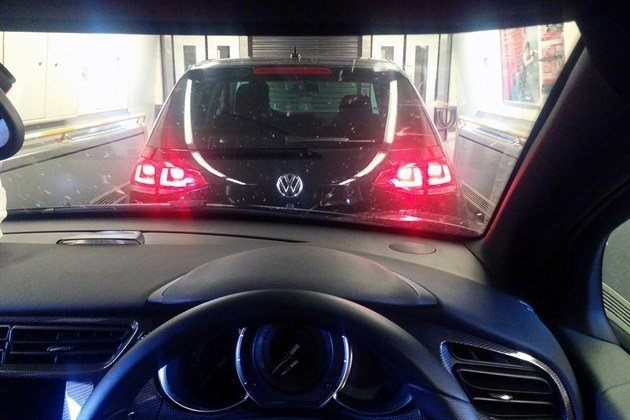
All aboard. There's a lot of flies on the windscreen...
1015
In typical style I forget that France is an hour ahead and find myself very confused. The sun is blazing and the in-car thermometer is reading 28 Celsius, so my passenger and I drop the roof and apply suncream, except for on one small spot on my neck where I quickly burn. Then we plan a route along the coast, parallel to the A16 toll-road.
1030
The DS3 is right-hand drive but that’s no real problem on French roads – it’s small enough to be confidence inspiring. That said, with the roof fully back the lack of rearward visibility is more of a problem here than in the UK. The KPH markings in the speedometer aren’t as clear as they could be, but they do the job well enough as we work our way through beautiful coastal roads.
1130
We stop at a small town called Etaples for a drink and to visit the largest First World War cemetery in France. It’s a moving experience, not least because this year marks 100 years since the start of the war, but because many of those who died were younger than me – and I’m not exactly an old man at 27.

Beautiful and poignant.
1200
It is lunch time, so we visit a place called Stella Plage. I topped up the fuel tank in London before leaving and since then we’ve covered around 150 miles, but there’s plenty of fuel left (partly because the tank is quite big for a small car). Average economy on the trip has been around 43mpg. That isn’t world-beating but the official figure is hardly staggering at 47.1mpg – so we aren’t doing too badly.
1300
We programme the sat nav to take us to our hotel, which is in Ruiel Malmaison, west of Paris. It goes insane, pinging up relentless messages about traffic problems from all over France, which interfere with the screen over and over again and make it hard to follow the navigation. We have to stop and figure out how to turn the messages off, at which point I realise the nav is avoiding tolls roads. This is corrected and we join the A16.
1400
My partner can’t drive, so her usefulness is limited to operating toll booths. These aren’t designed for right-hand drive cars so this is actually very handy. French motorways are excellent because they’re expensive and consequently nobody uses them, so you can travel at the 80mph speed limit uninterrupted for hours. At this speed the DS3 feels more at ease than it does at the UK 70mph limit, so its gearing was obviously designed for France and Europe rather than the UK.
1530
Paris is absolutely huge – and busy. We see a car forcefully pushing another car forwards in order to make a new parking space, which is disconcerting. Thankfully the hotel has underground parking, so we don’t have to drive into the fray. Instead we head to see the Arc de Triomphe and Eiffel Tower on the Metro. After some steak tartare and sight-seeing it’s off to bed – tomorrow the DS3 is going back to the factory where it was made.
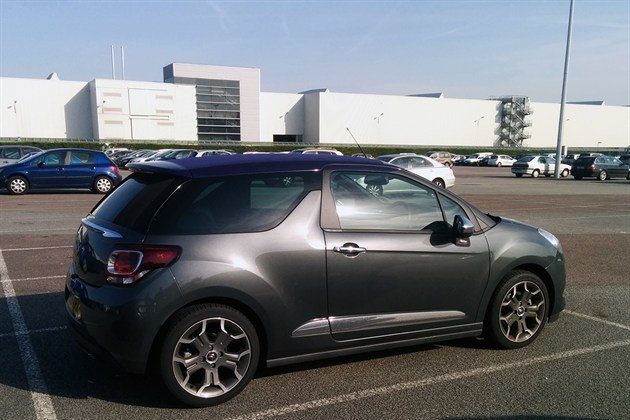
Nondescript - but this is the Poissy PSA plant, where the DS3 was built
Back to France: Part two
After a long drive and an evening in Paris it's time to visit the factory where the DS3 was built.
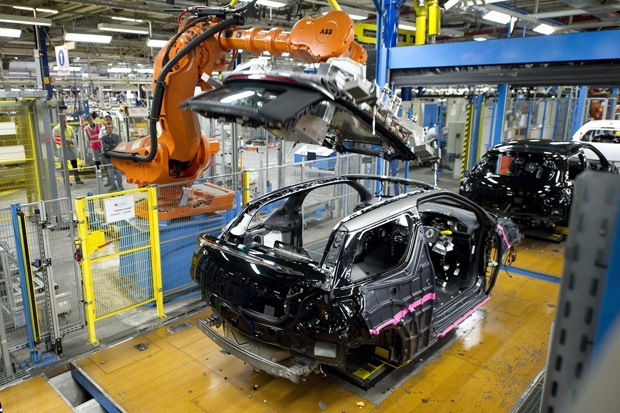
Date: 8 August 2014 | Current miles: 2890 | Claimed economy: 47.9mpg | Actual economy: 40.1mpg
After a long drive from London to Paris and an overnight hotel stay I got back into the DS3 and drove it to the PSA factory in Poissy, where it was built. It’s a huge, sprawling site built on the bank of the River Seine, to the North West of Paris.
It was originally opened in 1940, at which point it was owned by Ford. With the outbreak of war the plant produced trucks, and then eventually Ford passenger models again before it was sold to Simca in the 1950s. During the 50s the plant was heavily reworked and expanded and many of the huge buildings from that era remain today.
In 1978 the facility was taken over by PSA Peugeot-Citroen. It built some popular cars including the Peugeot 306 and 207. Today it produces the Citroen C3, the Citroen DS3 and the Peugeot 208 – with everything from stamping of sheet metal to paint and final assembly happening on site. The 208 runs down one production line while the C3 and DS3 run down another.
We took a tour of the factory and followed a DS3 along the production line. It started life as various rolls of sheet metal, which were then chopped to size by house-sized cutting machines before being stamped into shape by huge shaping tools at massive pressures. From there the production line begins, with a mixture of robots and humans working to get the cars finished.
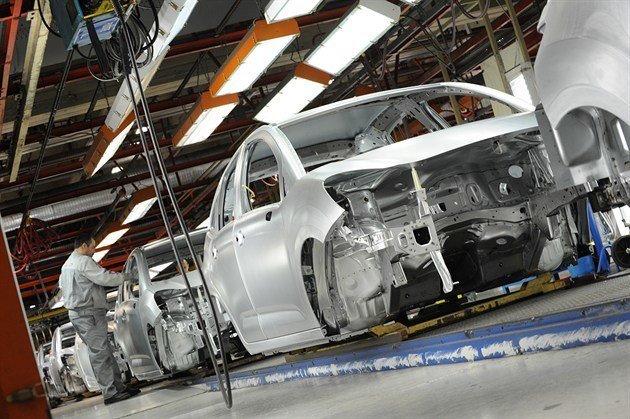
Initially the stamped metal parts are loosely bonded together by robots using glue, before being measured, checked and spot welded. Once everything is in order the spot welds are reinforced and then the body is more or less ready to be painted, but it’s first checked over by precise lasers for imperfections.
At this point things get a little odd – the PSA Poissy plant had no space for an advanced paint shop in any of the existing buildings, so one had to be built nearby. The cars are transported over to it in a huge gantry above the rest of the plant before being painted and sent back to the final assembly area. It's a limitation that reduces the output of the factory slightly, but it still manages almost 90 car per hour.
At the final assembly building the interior is installed, along with doors, bonnets, bumpers, lights and various other components like the engine, exhaust system, suspension and wheels. Right and left-hand drive models come along the production line together and there’s a mixture of DS3 and C3 models all chugging along the automated production line.
One thing the Citroen was early to the party with was customisation – every car at the Poissy plant has a code which explains to the various robots and staff what customisation is required, from colour combinations to optional extras – including the folding fabric roof of the DS3 Cabrio.
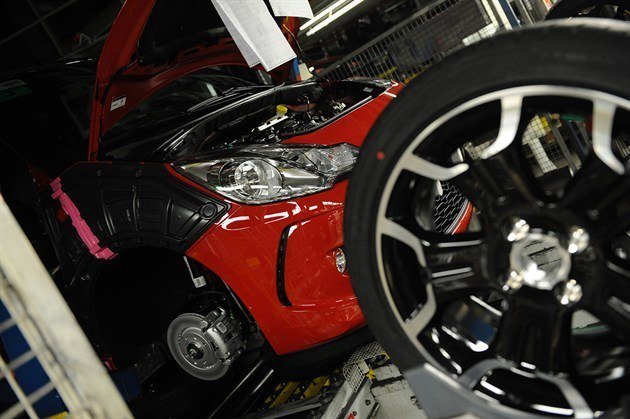
Throughout final assembly there are various picking areas, a bit like supermarket aisles, where customisation parts like dashboards and coloured trim finishers live for the day’s production run. These are collected in order by factory workers driving ‘trains’ like the baggage vehicles in an airport. They are taken to the right place to be installed in the right car.
It all looks very simple, but it’s an extremely technical process – the correct cars, parts, engines and ancillaries are all run down the line to the correct place at the correct time with absolute precision. To help keep the 'trains' to schedule, the various stops are named after French railway stations and everything is run to a schedule like a railway line.
Once the cars get to the end of the final assembly line they’re checked over to make sure everything is in order. They also undergo testing to make sure power outputs and major components are in order. One of the last stages of the process is a sticker area, where vinyl stickers are applied by hand on those cars that require them. After that it’s off to shipping. Cars for Europe typically end up on trucks, but there is a freight train station at the factory for moving cars longer distance or to sea ports.
Our DS3 started life here early in 2014 – it ran down the same production line and was checked by the same staff before being shipped to the UK for its pre-delivery inspection and registration process. And then, a few months later, it came back to the place it was built… quite an adventure for the little cabriolet. After taking it home, it was time to take ourselves home via the Autoroutes and Channel Tunnel.

Which engine?
We have the range-topping 155PS engine in our DS3 Cabriolet, but which is the best choice?
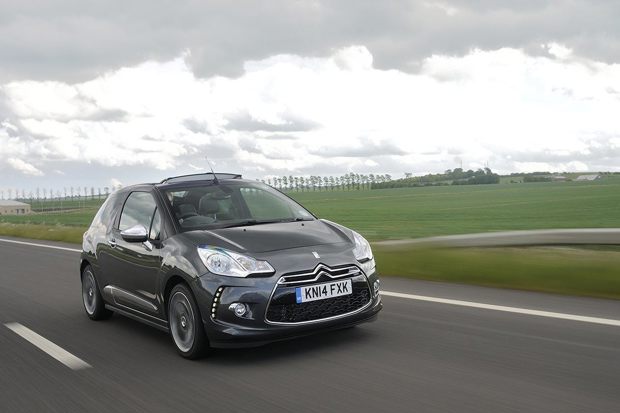
Date: 24 August 2014 | Current miles: 3125 | Claimed economy: 47.9mpg | Actual economy : 39.7mpg
Our DS3 Cabrio has a 1.6-litre turbocharged petrol engine – which is fantastic fun. Performance is impressive, with 0-62mph taken care of in an speedy 8.2 seconds. It sounds great, whirring as the turbocharger spools up and even subtly booming when you back off the throttle.
It’s really tractable too, thanks to the decent 240Nm of torque available across a good spread of the rev range. However it’s not really up-to-date when it comes to emissions and economy. Official economy is 47.9mpg but in reality we’re seeing closer to 40mpg most of the time.
Emissions aren’t particularly impressive either at 137g/km. Rival cars with similar power outputs often manage below 120g/km, meaning lower annual VED. Our DS3 costs £130 a year in tax, versus £30 for something like our previous SEAT Leon FR, a car with similar performance.
This might not matter to prospective buyers, of course – the DS3 Cabrio is, after all, a fun little fabric-topped car. Many will sacrifice some fuel economy for more enjoyment, especially if the car is reserved for weekends and warm weather. But there will be those who want to keep costs down.
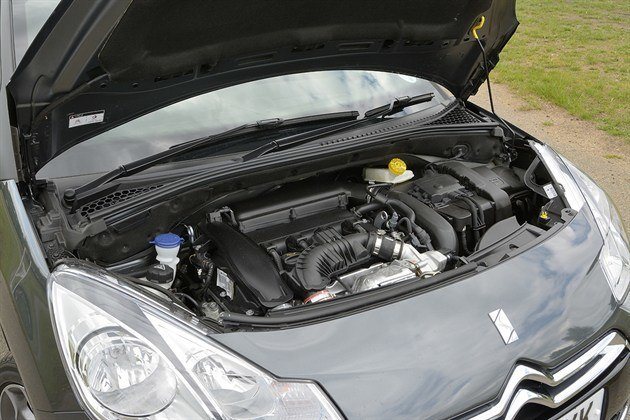
Doesn't look much fun - but it is.
So if you’re counting the pennies then a different engine choice might be a smart move. Thankfully Citroen has something to suit most needs, kicking off with a 1.2-litre VTi petrol. This little three cylinder engine might not be a strong performer, but for younger drivers it’s ideal, thanks to a low insurance group of 10E, versus 23E for the 155PS 1.6 THP.
It has decent economy and low emissions at 57.6mpg and 112g/km, respectively. For those who want to buy and run their DS3 Cabrio on a budget it’s the ideal choice. There’s also a 120PS VTi engine which offers a good blend of performance and running costs – though it doesn’t make quite as much sense as one of the diesels.
The most recent addition to the DS3 Cabrio range is the 120PS BlueHDi, which produces more torque than the 155PS petrol but offers genuinely impressive fuel economy. Official figures are 78.5mpg and emissions are very low at 94g/km – meaning free VED. In fact the only thing it doesn’t do compared to the range-topping petrol, is make a good noise.
Finally there’s a 90PS 1.6-litre HDi diesel. That 90PS might not sound like much but a useful chunk of torque produced low in the rev range, on-road performance is fine while overtaking and motorway work is no problem at all. Emissions are low at 95g/km so running costs should be affordable.
Personally I’m glad I chose the 1.6 THP 155PS range-topping engine. It might not be the most frugal or cost-effective choice, but with the roof down its booming, whoosing exhaust note and great power delivery make it fantastic fun – and isn’t that what a cabriolet is all about?
Make it your own
The DS3 is offered with all kinds of customisation options - what can you do to make it your own?
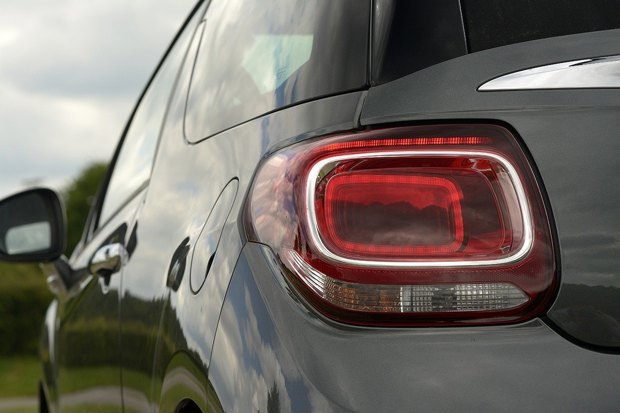
Date: 15 September 2014 | Current miles: 3263 | Claimed economy: 47.9mpg | Actual economy : 39.5mpg
The DS3 was one of the first cars – aside from the MINI – to offer a huge range of customisation options. Others manufacturers have since followed suit, including Vauxhall with its Adam. Like the hard top model, the DS3 Cabrio gets hundreds of colour and trim combinations to make it stand out.
Ours has an Infinity Blue roof (which is actually purple), along with grey alloy wheels and carbon-fibre effect interior details - but there are plenty of other choices. You can have chrome or painted door mirrors and side strips, for example, or blue alloy wheels if that’s your style.
There’s also white, grey, ‘Infinity’ blue or black interior trim detailing, along with a choice of roof colours. Particularly flashy buyers can go for a DS monogrammed roof in grey – plus there are some vibrant exterior paint finishes. Our car is ‘shark grey metallic’ but there are more colourful shades, including yellow or a deep shade of purple.
Upholstery choices are broad too, with various leather options including blue, black or white. For those who really want to stand out there’s a special edition designed in conjunction with Benefit cosmetics, which has pink badges and pink door mirrors.
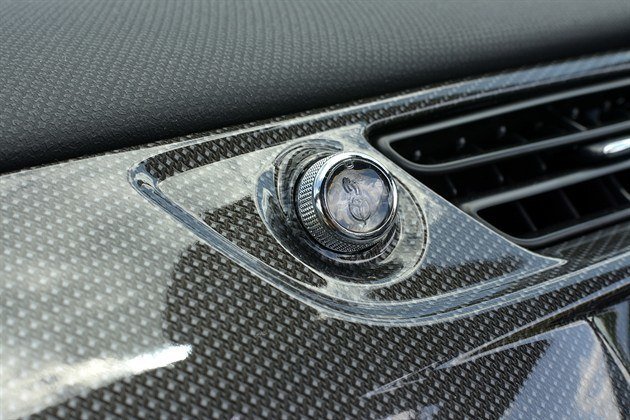
Carbon-fibre effect. Not quite the real thing...
All of the colour options and trim details are dependant on the equipment grade you go for – if, for example, you opt for an entry-level model you won’t get any leather seat options. Even so, there's a wide choice for all DS3 buyers regardless of how much they have to spend.
There aren’t too many accessories designed specifically for the DS3 Cabrio, which is a bit of a surprise, but many of the extras for the DS3 hard top will fit – and there are hundreds to pick from, most of which are dealer fit. That means you can swap and change even after you've bought the car.
Extras include everything from coat hangers that attach to the head rests to graphics packs, door sill protectors and gadgets like a DAB radio upgrade – something I wish I had picked when I chose our car. There are also practical extras like mudflaps and snow chains.
Having said all this, the MINI is probably still better if you really enjoy customising your car. There are more colour options, more interior options, more wheel choices and more extras packs – although it’s incredibly easy to go wild with them when designing your dream model, resulting in a hugely inflated price.
Winter is coming...
The weather isn't so cabriolet friendly now - but thankfully the DS3 is still performing admirably.

Date: 30 September 2014 | Current miles: 3396 | Claimed economy: 47.9mpg | Actual economy : 39.4mpg
It’s a shock when autumn arrives. It seems to rear its head so quickly, with blazing sunshine one day and orange leaves the next. Mornings are cold and rain tends to wet the ground for longer. It isn't great news for any car owner, but it's especially frustrating for those with cabriolets.
The DS3 is coping well enough. The roll-back top means the car feels more or less like a hard top when the roof is in place – it’s not really any colder, even if there is a bit of noise from the elements. The rear window is glass and has an element in for demisting – something that was often missing from cabriolets in years gone by.
Something that remains absent is a rear wiper – that’s the case with all rag top cars. It’s not too much of a pain though, thanks to good sized wing mirrors, offering plenty of rearward visibility. It’s something that you get quickly used to in poorer weather.
With cold roads, standing water and mulched up leaves all over the road it’s easy to lose traction when pulling away from a standing start, particularly with 155PS going through the front wheels. Thankfully the traction control system wakes up pretty quickly so you’re not standing still with tyres slipping all over the place.
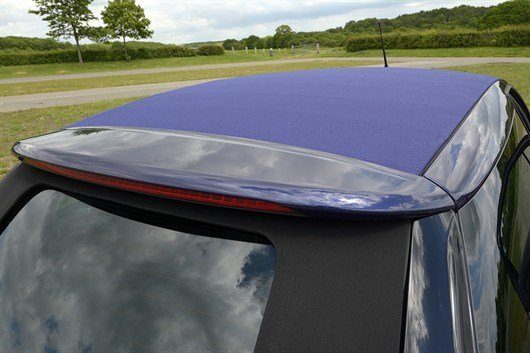
The roof is spending more time up than down these days
Losing traction is no problem when on the move though – there’s plenty of grip even when it's slippery. Thankfully 155PS isn’t enough to upset a proper hot hatch but it’s still a fairly significant power output for a small hatchback. However the DS3 isn’t daunting to drive when it’s raining and cold.
Obviously it would be better still on all-season or winter tyres, but the DS3’s tenure is almost up so it doesn’t make sense to fit them now.
Something that is getting tedious in this weather is the amount of rubbish and spiders that the canvas roof seems to accumulate. It’s always coated in leaves, red berries and bugs – and they don’t come off as easily as they would if the car was a hard top.
It’s possibly worse with the DS3 Cabrio than other cars because the weave of the fabric roof is very coarse – most fabric-topped cars have ‘smoother’ material on them which is easier to wipe down. They’re also often lower, which makes it easier still - it's pretty tricky to reach up onto the roof to pluck off bits of muck and dirt.
But it’s hardly the end of the world. After all, I tend to take the car to be cleaned by a valet anyway – I have far more important things to do than pick spiders out of my mirrors and scrub away dead flies – though they’re soon to be replaced by clods of mud and fallen leaves.
Au revoir, Citroen
It's time to say goodbye to our little Citroen DS3 Cabrio. And the stylish French open-top will be missed.

Date: 14 October 2014 | Current miles: 3632 | Claimed economy: 47.9mpg | Actual economy : 39.4mpg
The DS3 Cabrio’s six month tenure is up and it’s time it say au revoir. It’s been quite an adventure, with a sunshine-heavy drive all the way to the Peugeot/Citroen plant in Paris among the highlights. But as fun and likeable as the DS3 is, there are plenty of little flaws too.
The most notable of these is the boot, which in theory should be fine - it’s about the same size as the boot in a regular DS3 hatchback. But in reality it’s a pain in the backside to use because the tailgate is tiny. Getting a suitcase in is close to impossible - and it’s not even easy for the usual shopping trips because access is so low down and tight.
You get used to it, of course. Using the back seat as a storage area or travelling with soft bags instead of a proper suitcase becomes second nature after a few months, but if you have a pram – or indeed a child of any age – you might as well knock the DS3 Cabrio off your list. It isn’t what you’d call practical.
It is fun though. Our 155PS petrol model has more than enough power and torque to entertain you on a country road, plus it sounds great – especially with the roof down. And that roof is pretty nifty. You can retract or close it at any speed up to 70mph, so unless you’re being naughty you can read that as ‘whenever you like’.
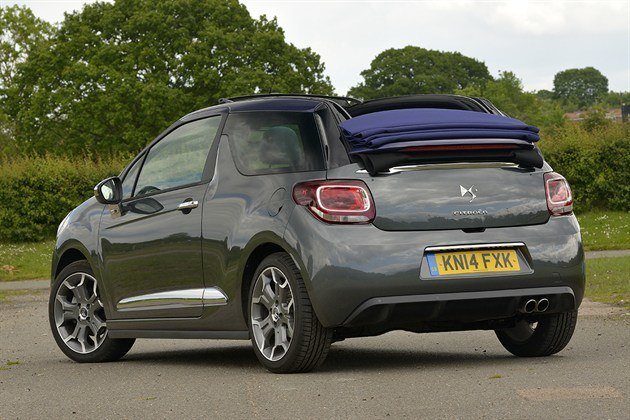
The DS3 is a car I won't be glad to see the back of...
Sure, it isn’t quite a proper cabriolet, but the experience isn’t far off. You get wind in your hair and the sound of the world around you, which is what a cabriolet is all about in my book. It’s a great companion on a dry, hot summer’s day, when the fun handling, great noise and the cooling effect of wind in the cabin combine not just to make the DS3 Cabrio an enjoyable car, but a memorable one.
Of course, then something else will come along and annoy you in a typically ‘French car’ way – like a navigation system that refuses to accept full UK post codes, or the complete lack of a cup holder, or the tiny glove box, half of which is occupied with the fusebox.
And yet, somehow, it’s all so easy to forgive. It has an endearing character that is unusual in many modern cars. Sure, it’s a bit irritating when you’ve just bought a Caramel Latte - but when you’re on a mountain pass in the Lake District you’d rather be in a fun, open-topped car without a cup holder than in a boring car with a cup holder.
As a summer car I thoroughly enjoyed the DS3. Getting in on a roasting hot morning and being able to immediately cool off the cabin was a treat. But even when the weather started to turn it managed to retains its charm and fun nature - so it will be a shame to wave the DS3 goodbye. Even if it is going at the very beginning of winter that's going to get extremely cold…


